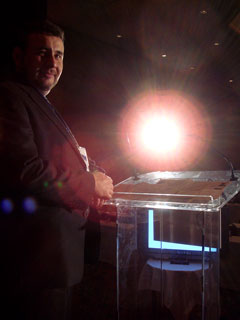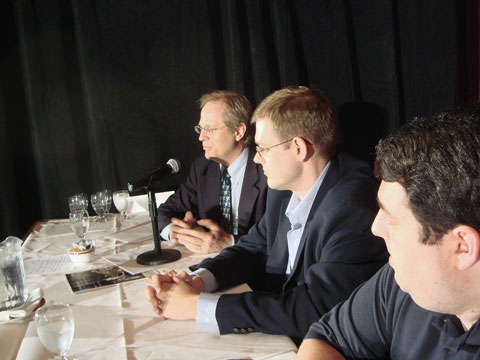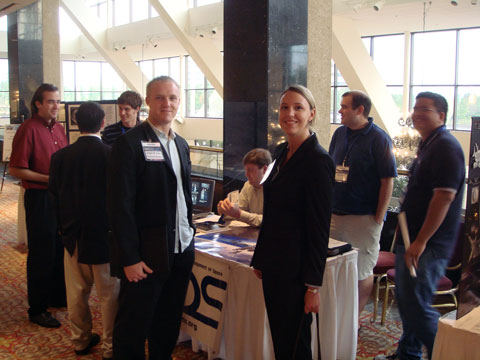
SO MY PANEL was on — hold your breath — blogging, and featured Anthony Duignan-Cabrera of Space.Com, Alan Boyle of MSNBC’s Cosmic Log, Rob Pearlman of CollectSpace, and uber-spaceblogger Jeff Foust. (Another uber-spaceblogger, Clark Lindsey, wasn’t here, and was missed.)
It was interesting, though the dramatic light meant that I couldn’t actually see anyone in the audience. It makes for pretty cool photos, though — this is moderator Anthony Duignan-Cabrera, who looks as if there’s a Martian sunrise behind him.
As I mentioned earlier, I haven’t been to an International Space Development Conference in years. Things have changed a bit, and that was probably more apparent to me than to people who have been going every year. But lots of people were remarking on some changes.
Most notably, the character of the attendees has changed. There’s less of a science-fiction-convention feel, as more of the people attending are actually making their living in the space biz, and particularly the commercial space biz. One of the people I was talking to last night was noting that there were a lot more attractive women than in the past, a change she put down to the presence of a lot more “good-looking men with money.”
There’s something to that, and Alan Boyle has a post on the entrepreneurial activity at the conference. I have to say that it’s the first time I’ve seen Brioni suits at an ISDC — as happened a few years ago with the nanotech conferences I attend, suddenly there’s a sizable contingent of venture capitalists, investment bankers, big-firm lawyers, and the like. There’s not a space bubble yet, but a guy I spoke with who knows a lot said that “the bubble’s scheduled for two years from now,” and that seems about right.
What’s going on right now isn’t vaporware, but real stuff. And what’s really interesting is that we’re seeing an entire infrastructure of secondary suppliers — engines, avionics, spaceports, etc. — springing up, often having contracts with numerous ventures. There’s also an interesting mix of cooperation and competition among the players, who all want to succeed themselves, but who also really want to see others make it too. It’s really looking more and more like the early days of the computer industry.
Below: (L-R) Alan Boyle, Jeff Foust, Rob Pearlman. Not pictured: Me, taking the picture.

It wasn’t all venture capitalists, though. There was a large contingent from Students for the Exploration and Development of Space. Those people go far — I found out that one woman I remember as a very active SEDS member from the early ’90s is now a professor of astronautics at MIT. Here’s the SEDS booth.

Of course, it wasn’t all entrepreneurialism and career opportunities. Sex in space remains a perennial favorite topic:

Surely this will give space tourism an, er, jumpstart. It’s clear, though, that the “NewSpace” entrepreneurialism is the source of the energy and excitement in the space community. There are some people who are excited by the Bush Administration / NASA Vision for Space Exploration initiative (more on that here and here) but while most people like the intent, it’s generally regarded as unlikely to get the longterm support from Congress that it needs to go anywhere. This view is apparently widespread within NASA, too, public statements to the contrary. The biggest fear is that we’ll wind up losing any ambitious programs, then trying to limp along with the Shuttle rather than bringing on a replacement vehicle as planned., But — and this is why people are excited — if the private space ventures succeed it won’t matter much as we’ll have access to orbit that way instead. Let’s hope that works out.
There was a lot of talk about the 2008 elections, as you might imagine. Bill Richardson is a clear favorite among a lot of people because of his excellent record on space entrepreneurialism in New Mexico. I heard someone talking about trying to sell Barack Obama on settling Mars (“Talk about an example of ‘the audacity of hope!’ This is it!”) but most doubt that either he or Hillary would be much good on space. Republicans are seen as representing something closer to the Bush Administration’s policies, which isn’t much of a compliment. Right now I don’t think that space is on any candidate’s radar screen very much. That may change: A good policy on space, particularly one that identified with the new entrepreneurial ventures, would get a candidate the support of some smart and energetic people, as well as imbuing his/her campaign with an overall sense of optimism and progress. Space still has a lot of mana, notwithstanding NASA’s problems.
One prominent space activist said that his strategy is to “save the baby” — that is, he’s not so much interested in getting Congress and the Administration to do what he wants, as just trying to ensure that they don’t manage to kill the space industries before they really get started (something that’s certainly not beyond Congress or, for that matter, the NASA bureaucracy if it feels sufficiently threatened).
And the best line on space policy is actually an old one from Rand Simberg, but it represents how the next Administration, of whatever party, ought to approach the subject: “It’s not NASA’s job to send a man to Mars. It’s NASA’s job to make it possible for the National Geographic Society to send a man to Mars.” Indeed.
UPDATE: Another report here.
And some earlier ISDC posts here (Mars rovers) and here (Buzz Aldrin). Or just scroll for multiple additional posts.
